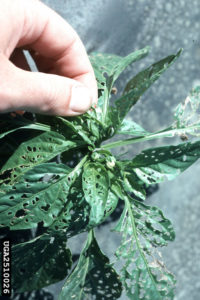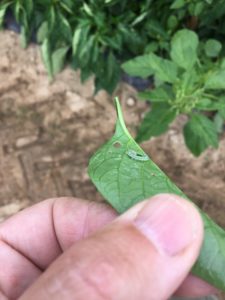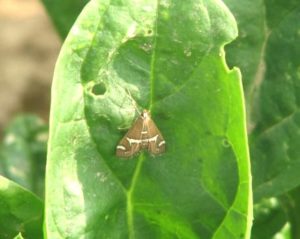Sweet Corn
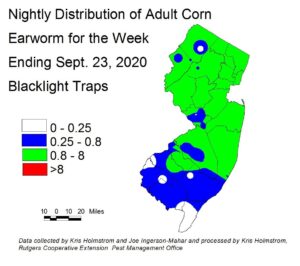 Corn earworm (CEW) moth captures have declined dramatically with cold night temperatures. As nights warm again toward the weekend, we may see some recovery in adult activity. Growers should consider this pest to still be at moderately high population levels in the state unless warmer nights indicate that the threat has diminished. The current population poses a significant risk to silking corn. Green areas on this map (see map at left) represent a 3-day spray schedule. However, night temperatures in the 40 to low 50 F range, may permit the extension of that spray interval by a day. For further information on CEW activity, see pheromone trap information below.
Corn earworm (CEW) moth captures have declined dramatically with cold night temperatures. As nights warm again toward the weekend, we may see some recovery in adult activity. Growers should consider this pest to still be at moderately high population levels in the state unless warmer nights indicate that the threat has diminished. The current population poses a significant risk to silking corn. Green areas on this map (see map at left) represent a 3-day spray schedule. However, night temperatures in the 40 to low 50 F range, may permit the extension of that spray interval by a day. For further information on CEW activity, see pheromone trap information below.
The highest nightly trap catches of CEW in black light traps for the week ending 9/23/20 are as follows:
| Long Valley 8 | Morristown 2 | Downer 1 |
| Hackettstown 3 | New Egypt 2 | Elm 1 |
| Denville 2 | Allamuchy 1 | Old Bridge 1 |
| Farmingdale 2 | Cedarville 1 | Tabernacle 1 |
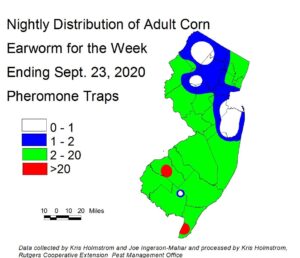 A similar temperature-based reduction in CEW pheromone catch occurred this past week (see CEW pheromone map at left). The blacklight network is still indicating a 3-day silk spray schedule in the northern counties, while the pheromone network is at 4-5 day. Under cold night conditions, it is possible to adhere to the more relaxed schedule, but growers should tighten up by a day if we return to warmer nights. The number of pheromone traps deployed is much lower, resulting in much broader color bands on the map. The current population continues to be an economic threat. It is important to use effective materials to manage this pest on silking corn. Insecticides in the IRAC 28 class (Coragen, Besiege, Exirel) and IRAC 5 (Radiant, Blackhawk, Entrust (OMRI approved)) remain among the most useful insecticides against CEW.
A similar temperature-based reduction in CEW pheromone catch occurred this past week (see CEW pheromone map at left). The blacklight network is still indicating a 3-day silk spray schedule in the northern counties, while the pheromone network is at 4-5 day. Under cold night conditions, it is possible to adhere to the more relaxed schedule, but growers should tighten up by a day if we return to warmer nights. The number of pheromone traps deployed is much lower, resulting in much broader color bands on the map. The current population continues to be an economic threat. It is important to use effective materials to manage this pest on silking corn. Insecticides in the IRAC 28 class (Coragen, Besiege, Exirel) and IRAC 5 (Radiant, Blackhawk, Entrust (OMRI approved)) remain among the most useful insecticides against CEW.
The highest nightly trap catches of CEW in pheromone traps for the week ending 9/23/20 are as follows:
| Monroeville 24 | Pedricktown 13 | Allamuchy 4 |
| Green Creek 23 | Eldora 11 | Crosswicks 4 |
| Woodstown 15 | Springdale 6 | Berlin 3 |
Silking Spray Schedules*:
South – 3-4 days
Central – 3-4 days
North – 4-days
*These recommendations are based on regional catches. Adhere to tighter spray schedules if indicated by local trap catches. Synthetic pyrethroids alone should NOT be used for corn earworm (CEW) protection on silking corn, or for fall armyworm (FAW) management at any stage. Control with these materials is very inconsistent.
Pepper weevil (PW)
Four on-farm pheromone trials were completed this week. The purpose of these trials is to determine which pheromones are the most specific and attractive to pepper weevils but no other weevil species. The pheromones were provided by Trece, the company that specializes in the development and marketing of insect pheromones and trapping systems.
The results of the trials will be available for the winter meetings.
Look for an announcement for a meeting this winter regarding the management of pepper weevils. Grower input is necessary to determine how to proceed with research and the best strategies for dealing with this pest.
Pheromone trap catches of beet armyworm (BAW) have decreasedin southern NJ traps. Scattered individual larvae continue to appear in some northern and central NJ cole crop fields. Growers should be alert to the potential for infestation from this pest. Look for clusters of pepper plants with lace-like damage to foliage near growing points (see photo at upper left). The green caterpillars will be found among these damaged leaves (see photo at lower left). After consuming foliage, BAW can begin to damage fruit directly. It is also important to note that BAW, like FAW, is resistant to synthetic pyrethroid insecticides. For this reason, materials in the IRAC 5 and 28 classes should be used in response to an infestation.
The highest nightly trap catches of BAW in pheromone traps for the week ending 9/23/20 are as follows:
| East Vineland 22 |
| Woodstown 8 |
| Cedarville 7 |
Pumpkins and Winter Squash
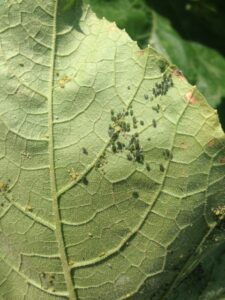 Melon aphid (see photo at left) populations may be present in pumpkin and winter squash fields. This aphid builds to heavy populations
Melon aphid (see photo at left) populations may be present in pumpkin and winter squash fields. This aphid builds to heavy populations 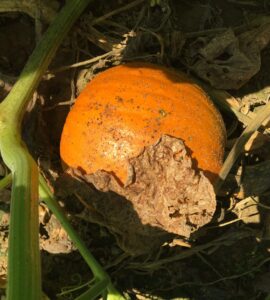 that result in the deposition of sticky droppings on the surface of fruit (see photo at right). If melon aphids appear in more than one sample site in a 10 site sample, consider treating to minimize the appearance of droppings. Insecticides effective at managing this pest are found in the Pumpkin and Winter Squash section of the Commercial Vegetable Production Recommendations.
that result in the deposition of sticky droppings on the surface of fruit (see photo at right). If melon aphids appear in more than one sample site in a 10 site sample, consider treating to minimize the appearance of droppings. Insecticides effective at managing this pest are found in the Pumpkin and Winter Squash section of the Commercial Vegetable Production Recommendations.
Cole Crops
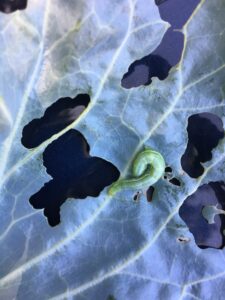 Fall plantings of cole crops are well underway at this time, and are frequently infested by imported cabbageworm (ICW) and diamondback moth (DBM) larvae. At this time, cabbage looper (CL-photo at left) and cross striped cabbage worm (CSCW-photo at right) are also causing
Fall plantings of cole crops are well underway at this time, and are frequently infested by imported cabbageworm (ICW) and diamondback moth (DBM) larvae. At this time, cabbage looper (CL-photo at left) and cross striped cabbage worm (CSCW-photo at right) are also causing injury to these crops.
injury to these crops.
Check 5 consecutive plants each in 10 random locations throughout the planting. Consider treating if caterpillars are found on 10% or more plants that are in the 0-9 true leaf stage. From 9-leaf to the early head stage (in broccoli, cauliflower, and cabbage) infestations up to 20% may be tolerated. Once heads begin to form, a 5% threshold should be observed to protect the marketable portion of the plant. For leafy greens such as collards and kale, 10% plants infested is the threshold throughout.
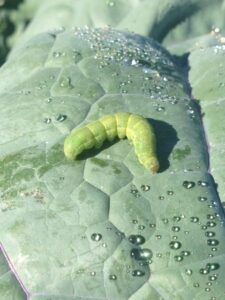 Some populations of DBM are resistant to carbamate and synthetic pyrethroid insecticides. The lack of DBM control with these insecticides has been noted in NJ previously. It is important to distinguish between common cole crop pests for this reason. DBM larvae grow to a length of approximately 0.5”, and taper toward both ends (see photo at right). These caterpillars thrash violently when disturbed. Newer chemistries that specifically target caterpillar pests are effective against DBM as well as all other caterpillar pests of cole crops, including beet armyworm (BAW-see photo at right), another species with exhibiting pyrethroid resistance. These materials include (active ingredient – trade name (IRAC* code)):
Some populations of DBM are resistant to carbamate and synthetic pyrethroid insecticides. The lack of DBM control with these insecticides has been noted in NJ previously. It is important to distinguish between common cole crop pests for this reason. DBM larvae grow to a length of approximately 0.5”, and taper toward both ends (see photo at right). These caterpillars thrash violently when disturbed. Newer chemistries that specifically target caterpillar pests are effective against DBM as well as all other caterpillar pests of cole crops, including beet armyworm (BAW-see photo at right), another species with exhibiting pyrethroid resistance. These materials include (active ingredient – trade name (IRAC* code)):
Spinosad/Spinetoram – Entrust(OMRI)/ Radiant (5)
Chlorantraniliprole – Coragen (28)
Cyantraniliprole – Exirel (28)
Spinach, beets and chard
Hawaiian beet webworm (HBWW) moths have been detected on central and southern NJ farms. Thus far, these moths have been seen in weedy areas of non-host crops. The moths are quite numerous where they have been found. Farmers with spinach, beets, and chard should check their fields for the presence of webbing and feeding injury. These are small migratory moths usually occurring in mid-to-late summer. Their favored host is the pigweed, Amaranthus sp., but they are capable of causing defoliation and contamination to crops. Since they are migratory and have a short life cycle they can rapidly appear and cause extensive damage to crops unnoticed.
Allium Leafminer
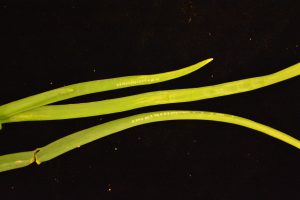 It is allium leafminer (ALM) season again, and growers of leeks, scallions, etc. should be protecting crops either with row covers, or with labeled insecticide appliations targeting adults. See photo at right, of adult egg-laying scars on scallion leaves. Spinosyn materials (Radiant, Entrust (OMRI approved)), pyrethroids (Mustang Maxx, Warrior), neonicotinoids (Scorpion, Venom) and the insect growth regulator Trigard are labeled for miner control. The diamide, Exirel, is permitted in NJ under a 2ee label as well.
It is allium leafminer (ALM) season again, and growers of leeks, scallions, etc. should be protecting crops either with row covers, or with labeled insecticide appliations targeting adults. See photo at right, of adult egg-laying scars on scallion leaves. Spinosyn materials (Radiant, Entrust (OMRI approved)), pyrethroids (Mustang Maxx, Warrior), neonicotinoids (Scorpion, Venom) and the insect growth regulator Trigard are labeled for miner control. The diamide, Exirel, is permitted in NJ under a 2ee label as well.
